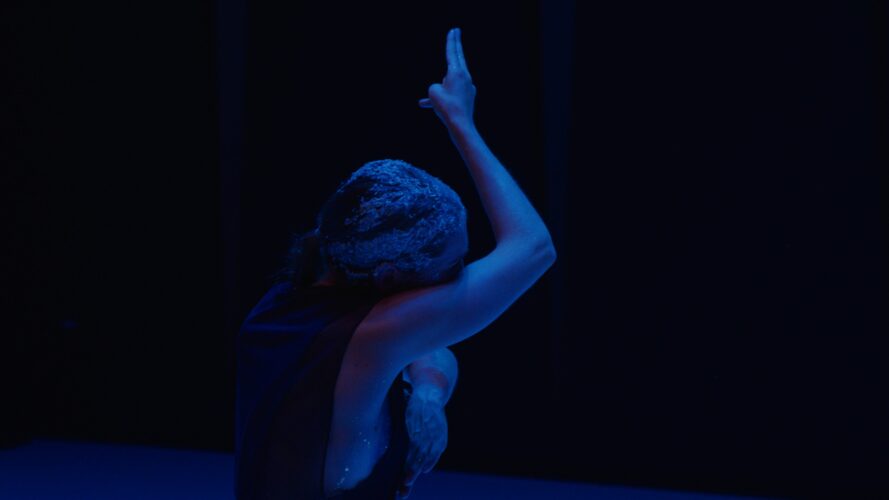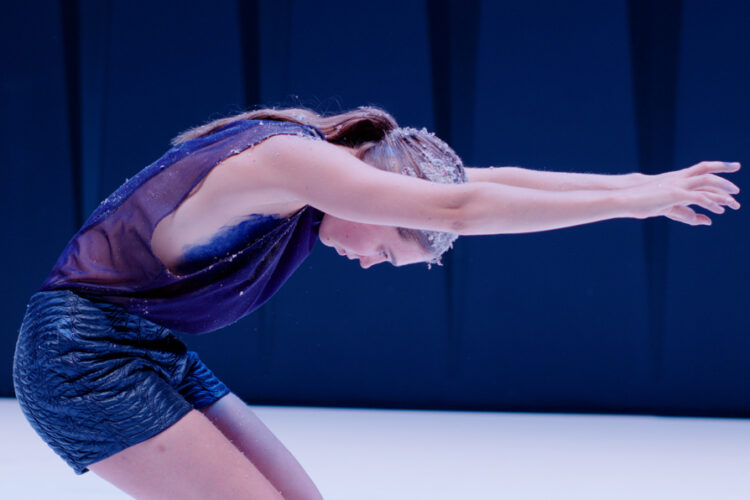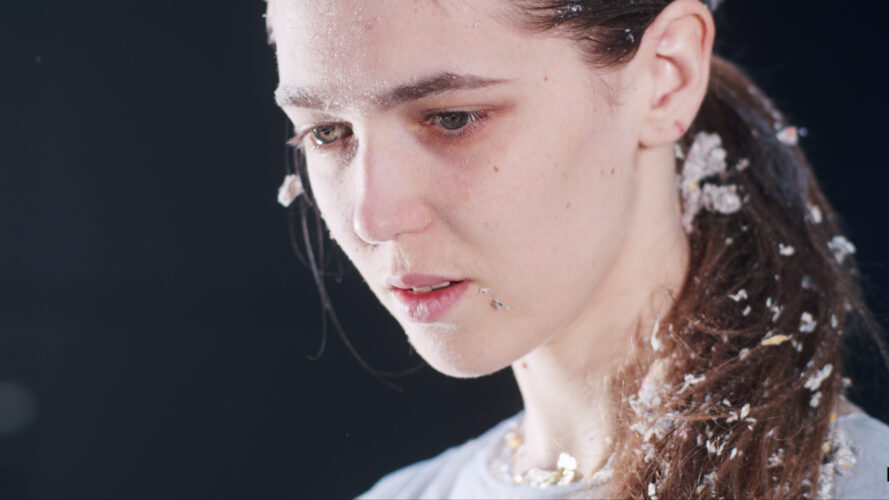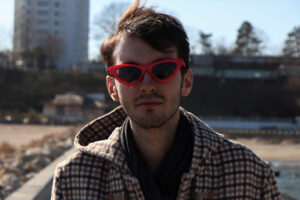Throughout November, the National Center for Dance Bucharest – which celebrates its empowering 20th anniversary this year – organizes Iridescent, an international festival of contemporary dance and other reconfigurations of the sensibile. It is a festival of the most eclectic, national and international performances, a festival of atypical yet necessary artistic proposals, of revolutionary or tender questioning about the world we live in. In the middle of the festival, on November 14 at 7:30 pm at Stere Popescu Hall (80-82 Mărășești Boulevard), the public will meet Léa Vinette. The French-born choreographer and performer invites local audience to attend NOX, an intense choreographic solo in which light and darkness become the two pendants of an ever-changing identity… In anticipation of her arrival in Bucharest, we got to know the very talented Léa through the interview she gladly offered.
I’ll start our discussion with an intuition, which I invite you to contradict, if need be: it seemed to me that the liberated and liberating tension in this solo, your first creation, came after a time of solitude or at least of deep introspection. Watching the recording of the piece, I had the feeling of an “awakened” body – an image of presence coming to the surface… Please tell me more in this regard.
Indeed, there was a long time spent alone in the studio, driven by a strong urge and desire to create a solo. I would go into the studio, try exercises from Meg Stuart’s book, get distracted, eat alone there, sing into a microphone with lyrics in front of me, put on a song that really energized me to move, and so on. One day, I lay down on my belly for a long time, just resting, not knowing what to do. Slowly, a powerful feeling grew in my belly, and I began to cry and scream, very loudly (I was in a studio at Les Ballets C de la B in Ghent, in an industrial area with barely anyone around). These sounds expressed a contradictory emotion: a visceral sense of being completely alone in life, realizing that no one truly has access to my mind, my perspective, my feelings; and, at the same time, feeling intensely alive, with a strong drive and power to live and move. This contradiction guided me throughout the process of creating NOX. It took two years in total before the premiere, allowing time for the material, dramaturgy, and intentions to mature.
As NOX was my first creation, and even more so a solo, it became my first true choreographic gesture (not counting school projects). Inevitably, a new language surfaced through it. I was very happy – though it wasn’t always easy – to take this time, as I feel it allowed me to truly discover my own choreographic vocabulary. And yes, there is a real sense of freedom in the piece, both in me becoming an author and in the gradually more expansive and expressive movements within the solo itself.
You studied dance in Nantes, Lyon, The Netherlands. Although you don’t recite text, although you are not “figurative” on stage – on the contrary, you work very abstractly, but in no way artificial – you also have a particular theatricality, Léa. What are the academic or personal sources that triggered or inspired this state of spectacular expressivity?
Thank you for the compliment! When I was a child, I did both dance and theater. I used to compete in theater improv games, which was a lot of fun. I loved both dance and acting, and I always wanted to be an actress in some way. But I wanted more hours, and in my city, acting didn’t have a specialized program, whereas dance did at the conservatory. So, I chose to dance every day, and then I had no time for anything else – which, of course, I loved! So maybe part of me channels that love of acting through dance.
After that, it was mainly the people I met in the studio and the choreographers I worked with who inspired me to explore emotions and expression – like Ido Batash and Tabea Martin.
Others inspired me through imagination, sensation, and somatic practices, like Louise Vanneste, Marielle Morales, and Florence Augendre. I was also really inspired by the work of Alain Platel and Marlène Monteiro Freitas, who both have such expressive languages.
This side of my dance isn’t really academic, but certain books help deepen my reflection on these emotional and physical intuitions. Some that come to mind are The Birth of Tragedy by Friedrich Nietzsche, In Praise of Risk by Anne Dufourmantelle, and The Psychoanalysis of Fire by Gaston Bachelard.
Your show is presented in Iridescent on November 14 and focuses, among other things, on the concepts of darkness and light, which I have also interpreted as symbols for interiority and exteriority, as potentiators of two different ways of being. The question is a bit lyrical: who are you when everybody sees you and who are you when nobody sees you? I’m interested, in the multiplicity of who you can be, about that Léa-before-falling-asleep-at-night and that Léa-who-gets-standing-ovations-after-a- performance.
I really appreciate your parallel between darkness and light with interiority and exteriority. While performing, I often focus my attention inward (on physical sensations) and outward (on the environment, like the audience, the lights, the sound, etc.). I believe this interplay allows for a simultaneously open and mysterious presence.
When everyone sees me, I can act like a little clown – very spontaneous and social. I jump from one idea to another, fueled by a sort of hyperactive energy I get from being with others, perhaps by being seen and seizing the opportunity to perform. Alone, or in a very intimate setting, I can be quite serious, delving into the depths of human behavior and reflecting deeply on my relationships. I can also experience sadness and emotional intensity, sometimes to a dramatic degree, feeling overwhelmed by the situation.
With others, I can take on a leadership role, being directive and optimistic, cheering and demanding. Alone, however, I can feel overwhelmed by the number of tasks I’m considering and the need to fix them all immediately, which brings a form of impatience and perfectionism. I increasingly realize that, for me, dance is a way to fully inhabit the present and to survive the ongoing flow of speed, information, and pressure. Through dance, I can play, acting out and experiencing emotions or characters that aren’t “allowed” or possible in my real life. These emotions originate from parts of myself but are expressed and extended on a much larger scale, both physically and intensely. To achieve this, it feels as if I empty myself or disappear, becoming a vessel – allowing my body to serve as a storehouse of images and emotions, like an archive.
You already have two creations of your own, NOX and Nos FEUX, but you have performed in numerous other works and performative contexts as dancer. How did your intimate relationship with the stage, the audience and your own body has changed in the transition from performing to creating something on your own?
NOX is the only solo piece I perform, and it definitely comes with a lot of responsibility – especially because I’m both the performer and the creator, so it’s double! But after performing it quite a few times, I gained confidence and lost that sense of needing to prove myself. This has given me so much freedom – the ability to really be in the moment and the trust to be very honest, allowing for both vulnerability and power.
With touring NOX, I let myself enter the work as the “new, updated Léa” – both as choreographer and performer. This is something I do as a dancer for other choreographers too, asking myself, “How do I want to approach this piece today?” or “What is my physical and mental focus for this show?” or “What do I want to explore tonight?”.
Somehow, though, this feeling is amplified with my own work, since I feel more evolved and accountable. I really value this growth because it shows me I’m changing, that my artistic vision is developing, and (hopefully) that my performance skills are improving.
In relation to my body, it feels somehow easier to find my own paths to move in certain ways. With other choreographers, it often takes a bit of time to combine my personal way of moving with the language of their work. I think I’ve also allowed certain expressions of my body that I hadn’t before, which feels liberating.
But personally, I need both: continuing to work as a dancer for others and creating my own pieces. The challenge and discovery of dancing for a choreographer is a great journey that lets me uncover and understand things I wouldn’t have thought of on my own.
In your biography I stumbled upon a concept I am not very familiar with – fasciapulsology. I understand it’s a kind of therapy involving touch, that has many physical and emotional benefits. I’m wondering how you relate to the idea of trauma in the body: do you prefer to work with a body that is “emptied” of its “difficult” contents, or on the contrary, do you prefer a body “loaded”, so that it has something to release on stage?
It’s an interesting question, as I’ve never really asked myself this before. In a way, I feel I work with both. I start with an “emptied” body that can be inhabited by emotions, figures… as if it weren’t me doing these things, these movements – as if I were letting myself be possessed by something else. This brings to mind the idea of a receptive body, open to movements and emotions, almost like a channel or vessel for something greater or external. But once these different figures, emotions, or physicalities have “come out”, I select, choreograph, and repeat them. In the end, I embody or perform them with a “loaded” body – or at least, one that is charged and fully engaged, from fingertips to toes, from every cell. Even if the movement is minimal, the entire body is deeply present and engaged.
You are a CNDC-Angers associate artist until 2027 – congratulations! With reference to that, what is your main quest/pursuit in the coming period?
Thank you! It’s incredibly special to be associated with such an amazing institution for three years; I feel very fortunate and grateful! Sometimes, it still feels almost surreal.
I’ve just started the research phase for my third piece, which will begin creation in June 2025, with a premiere planned for 2026. This trio will continue my exploration of vitality, focusing this time on the relationship to rhythm and musicality, as well as the contrast between collective dynamics and individual expression. I want to simplify the elements I’m working with – no scenography or sets, very minimalist lighting – so I can delve deeply into physicality, spatial organization, and the imaginative or poetic images that emerge directly from the performers’ movements.
Through this new project, I aim to continue developing my choreographic language and learn how to work effectively with performers and a full team. This aspect is still quite new to me, and it seems that the best way to learn is to dive in – to experience the reality of it: organizing the creation weeks, building a team, creating a schedule, and figuring out how to invite the dancers into my world both physically and emotionally.
To deepen my practice and refine my tools, I’ll also be giving workshops – for example, within Iridescent, a day after my show. This too is relatively new for me, and it’s an ideal setting since there’s no pressure to produce a final result or incorporate elements like lighting, set design, or dramaturgy, which can sometimes feel overwhelming. I’m really eager to explore how to share and expand my language with other dancers outside of a creation process!
There is something very dreamy about NOX. What do you dream about most often, Léa? What alternate worlds or temptations do you usually escape to in your head? What takes you far, far away?
There’s something about being on a train, watching the landscape rush by, that’s perfect for dreaming away. I always imagine a little character jumping across the scenery, dancing, and moving along at high speed. Music is the most powerful tool for me to escape – and even more so when I’m dancing to it.
In my dreams at night, it’s usually my fears that surface, often set in realistic scenarios. When I was young, though, I remember dreaming in vivid colors, surrounded by a lush, plant-like world. One of my favorite moments is that state between sleeping and waking, when thoughts and images flow in, and you’re aware of them but too tired to move or do anything with these passing associations. Showers also have this magic for me – they might not be for dreaming away, exactly, but they’re perfect for literally and mentally washing away thoughts or worries. They leave me with a clear mind and, often, great ideas.
The difference between light and darkness is perhaps one of the most fundamental, the simplest to understand. On the premise that there are contrasts and contradictions that frustrate us, and contrasts and contradictions that we couldn’t live without, give me examples of some things that fall, for you, into each of these two categories.
Contradictions that frustrate me: the need to be fully present in the moment while also feeling the constant pressure to organize for the future. I often feel the need to rest and recharge, yet I struggle to resist the urge to be active and pursue my goals. There’s also a contradiction that, while it doesn’t frustrate me, can be confronting: the desire to create new works and pursue my artistic ambitions, paired with the fear of failure or the nagging thought that my creations might never measure up to those of the artists I admire
Contradictions that I couldn’t live without: the balance between creativity and structure. I love having the freedom to explore my artistic vision, but I also need some structure to make it work. Without it, I can feel lost, and too much rigidity can kill my vibe. Vulnerability and strength are essential to me, both in my daily life and in my art. I believe I need to be open about my weaknesses to grow, connect deeply with friends and family, and create. At the same time, I also require strength and confidence to take risks and push myself. In my dance, expressing power is one of the qualities I strive for, aswell as that very fragile and open quality.
In the video I saw, part of the audience is at stage level, right on the dance floor, where you perform. How do you relate to the audience in general? What physical and emotional dynamics do the witnesses activate in you?
I think of the audience as a group with whom I’m sharing the journey of the piece. With the intimate, bi-frontal setup, there’s a real feeling of being together “in this”.
While the choreography and spatial setup are all defined, both the performative energy and my presence have set intentions, with space for openness. This means I’m often “using” my sensations as the source for movement, as well as for its quality and rhythm. Within these sensations, there are inner ones (what I feel inside my body) and outer ones. The audience – its presence, its energy, its movements – is one of the external sensations that feeds my dance.
Sometimes, it’s as direct as looking someone in the eyes, meeting a person for just a second, but other times, it’s listening to their presence through my back – fully including each of them on a sensory level so that we move through the experience together.
In a kind of synesthetic exercise, what is the book underneath this performance? What is the song? What is the flavor?
The book behind NOX: Nightfall by Isaac Asimov.
The flavor behind NOX: water, for two reasons. Im very thirsty after the show, and it is one of the image I use for a physical state at the beginning, I play with the difference movements and textures of water inside my body (ice breaking, small streams, big streams etc).
The song behind NOX: Not my responsibility by Billie Eilish, on which I developed one of the sequences in the piece. Also, I warm-up listening to the complete album Getting Older before performing!
You confess to be interested in the viscerality, the unspeakability of certain moods and sensations. In counterpoint, what is the most “pragmatic” aspect that characterizes you on or off stage? But the most “political” one?
I’m deeply drawn to the visceral and unspeakable aspects of sensation and mood, where expression moves beyond words into something almost raw and instinctual. But on a more pragmatic side, I think I’m quite intentional about creating structure in my creative process – whether it’s setting goals, scheduling rehearsals, or fine-tuning the timing and spatial organization within a piece. I find that having a solid foundation in these practical areas actually allows me to dive even deeper into the more intangible parts of the work without losing balance.
On a more political level, my work often revolves around exploring the complexity of emotions and the body’s power to express vulnerability and strength, which I see as a kind of resistance to society’s expectations about how we should feel or act. In NOX, for instance, I let the physicality of the solo speak to themes of female power and freedom, bringing to the surface emotions and movements that feel unrestricted by stereotypes. I hope this focus on emotional and bodily authenticity can invite audiences to see, and maybe even question, certain societal norms or expectations.
To whom do you dedicate the NOX performance on November 14th in Bucharest?
I will dedicate the performance in Bucharest to my grandmother, who passed away two years ago. When I read your question, she was the first person who came to mind – perhaps because dedicating a piece often feels connected to someone who has passed. I often ‘invite’ certain people into my thoughts as a form of support for each show, but this dedication feels different.
I was close to my grandmother, and once, I asked her to dance to Chopin’s music on camera. I filmed her from behind, and in a way, we were dancing together with the camera between us, capturing her movements. This film is deeply moving to me, and I carry this memory close to my heart.
As the performer in NOX, the piece inevitably touches on themes of female strength, vulnerability, and emancipation. In a way, it feels right to honor her through it.
Thank you, Léa. See you in Iridescent on November 14.
POSTED BY
Mihai Ivașcu
Mihai Ivașcu (b. 1997, Bucharest) writes poetry and theater and works as a communication specialist. He holds a degree in Advertising, completed a master's degree at CESI with a focus on performing a...






Comments are closed here.